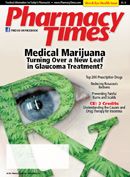Publication
Article
Pharmacy Times
First Aid Products for Wound Care
Author(s):
When it comes to minor wounds, pharmacists can help patients assess if self-treatment is appropriate and recommend products to promote healing and minimize scars.
When it comes to minor wounds, pharmacists can help patients assess if self-treatment is appropriate and recommend products to promote healing and minimize scars.
There is a variety of OTC products available for the self-treatment of minor wounds, such as scrapes, scratches, and cuts. Pharmacists are in a pivotal position to ascertain the appropriateness of self-treatment, guide patients on the proper selection of first aid products, and direct them to seek further medical attention when warranted.
Classification of Wounds
Determining the type and severity of a wound is key to implementing proper wound care. Wounds are classified according to their acuity and depth.1 Examples of acute wounds include abrasions, punctures, and lacerations.1 Abrasions are an injury of the epidermal portion of the skin typically caused by rubbing or friction.1,2 Punctures are the result of a sharp object piercing the epidermal layer and lodging into the dermis or deeper tissues.1 Lacerations are caused by sharp objects piercing through various layers of skin.1,2
If acute wounds do not extend beyond the dermis, self-treatment is usually appropriate.1 Individuals with chronic wounds should always be advised to seek medical attention to prevent the possibility of infection.
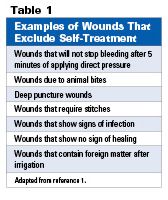
Wound Care Protocol
The overall goals of wound care treatment are to promote healing, prevent infection or further complications, and minimize the effects of scarring.1 Self-treatment for minor wounds typically should include the following 3 steps3-5:
1. Cleanse the affected area thoroughly with soap and water.
2. Apply an antibiotic ointment to prevent infection.
3. Cover with a sterile bandage to create a moist environment to promote healing and minimize incidence of scarring.
OTC Wound Care Products
Examples of OTC wound care products include topical antibiotics, irrigants, antiseptics, various types of bandages, and products that aid in reducing the appearance of scars.
Wound Irrigants and Antiseptics
In many cases, wound irrigation is necessary to clean the wound surface if dirt or debris is present.1 A normal saline solution or a mild soap and water can be used. In addition, various topical antiseptics are available to disinfect the skin.
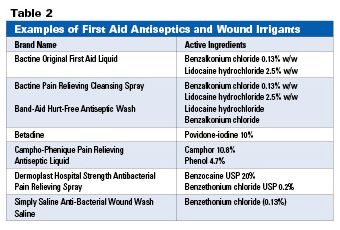
Antiseptics should only be applied to intact skin up to the edges of the wound.1 Examples of first aid antiseptics include ethyl alcohol (48%-95%), isopropyl alcohol (50%-91.3%), iodine topical solution USP, iodine tincture USP, povidine/iodine complex (5%- 10%), camphorated phenol, quaternary ammonium compounds, and topical hydrogen peroxide solution (0.13%).1
Topical First Aid Antibiotics
Available OTC topical antibiotics include polymyxin B and a combination of bacitracin, neomycin, and polymyxin B sulfate. Some also contain the anesthetic lidocaine for pain relief. These products are indicated for the prevention of infection in minor cuts, wounds, scrapes, and burns.1 These products should be applied after a wound has been cleansed and followed by the application of a sterile dressing.
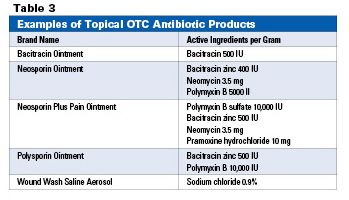
In order for wounds to heal properly, it is important for patients to be educated on proper wound care. For years, many individuals believed that minor wounds should be left uncovered to heal quicker; however, research has shown that uncovered wounds have increased chances of scarring, possible infection, and reinjury.1,4,5 A moist healing environment is now considered to be the standard of care, because it appears to accelerate healing and may minimize scarring and reduce incidence of infection.1,4,5
It is important to remind patients to properly cover minor wounds with appropriate wound dressing products, such as Band-Aid (Johnson & Johnson), Nexcare (3M), or Curad (Medline Industries) products. Band-Aid carries a bandage
product with a topical antibiotic for added convenience, and
the antibiotic ointment Neosporin (Johnson & Johnson) is available in a small portable container or single-use dosage form.
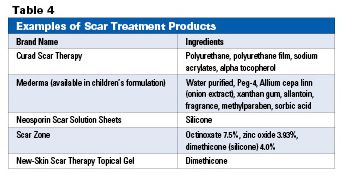
Patients should be instructed to change dressings only when dirty or not intact.1,4,5 Many dressings should be changed every 3 to 5 days unless otherwise directed. Frequent dressing changes may remove resurfacing epithelial layers and may slow down the healing process.1,4,5 Patients should be advised to continue using wound dressings until the wound shows signs of healing. If scars occur, there are OTC products available that can aid in reducing their appearance.
Because certain medications or medical conditions can hinder or impair healing, pharmacists should remind these patients about the importance of following protocol for minor wound care and should be encouraged to seek the advice of their primary care provider if needed. Patients should always be advised to seek medical care for wounds that do not exhibit any signs of healing after 5 days of self-treatment, or if the wound shows signs of infection, such as redness or swelling. Factors affecting wound healing include decreased tissue perfusion and oxygenation, inadequate nutrition, increased age, and uncontrolled diabetes, and the use of certain medications (corticosteroids, antineoplastics, anticoagulants).1 â–
Ms. Terrie is a clinical pharmacy writer based in Haymarket, Virginia.
References
1. Benard D. Minor Wounds and Secondary Bacterial Infections. In: Berardi R, Newton G, McDermott JH, et al, eds. Handbook of Nonprescription Drugs. 16th ed. Washington, DC: American Pharmacists Association; 2009: 759-773.
2. Abrasions. Merck Manual Online Web site. www.merck.com/mmpe/sec21/ch308/ch308a.html#sec21-ch308-ch308a-96. Accessed February 28, 2010.
3. Hollander JE, Singer AJ. Evaluation of wounds. In: Tintinalli JE, Kelen GD, Stapczynski JS, Ma OJ, Cline DM, eds. Emergency Medicine: A Comprehensive Study Guide. 6th ed. Columbus, OH: McGraw-Hill; 2006:chap 40.
4. Clean, Treat, Protect. Wound Care. Band Aid Web site. http://www.bandaid.com/cleanTreat.jsp. Accessed February 27,2010.
5.Neosporin Web site. www.neosporin.com/firstaid/pdf/sciencefactsheet.pdf. Accessed February 25, 2010.
